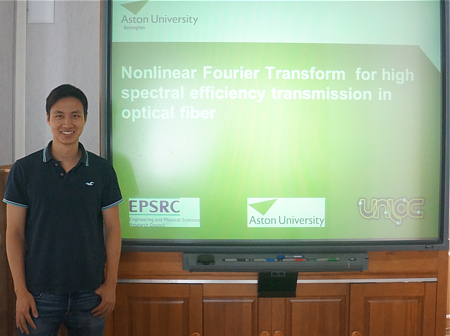
Прочитан курс лекций для сотрудников лаборатории нелинейной фотоники НГУ
Молодой специалист Son Thai Le из Института фотоники университета Астона (Великобритания) прочитал в НГУ для сотрудников лаборатории нелинейной фотоники курс лекций на тему "Технология мультиплексирования с ортогональным частотным разделением каналов и нелинейное преобразование Фурье для оптической связи".

Программа лекций:
Talk 1: Introduction to OFDM
In this lecture the basic concept of orthogonal frequency division multiplexing (OFDM) will be discussed. We review briefly the history of OFDM transmission scheme, from wireless communication and the recent adaptation of OFDM in fiber-optics communication. The basic concepts of fiber-optics communication, e.g. optical modulation, fiber link, coherent detection are also discussed.
Talk 2: Analog vs Digital OFDM
In this lecture, we compare the designs of analog and digital OFDM transmission schemes for fiber-optics communication. We present and discuss in details the design and DSP blocks for digital OFDM systems, including digital mapping, cyclic prefix insertion, channel estimation, channel equalization and phase noise compensation.
Talk 3: Modeling of Digital OFDM systems
In this demo, we will demonstrate the numerical modeling of digital OFDM system using MATLAB.
Talk 4: OFDM vs Single Carrier
In this lecture, we will compare OFDM and single carrier transmission schemes, from the terminology to the design and performance, for optical communication links. The nonlinear performance of OFDM systems with and without dispersion compensation modules is discussed. We also discuss peak-to-average power issue of OFDM and methods for its reduction with special attention on DFT-OFDM transmission scheme.
Talk 5: Performance estimators and phase noise compensation for OFDM
In this lecture, firstly we will discuss common performance estimators in optical communications, including BER, EVM and Q-factor. We then discuss the statistic properties of the received symbols’ phases in CO-OFDM systems and a BER estimation method based on these statistic properties. Finally, the impact of laser phase noise and two recently proposed techniques for phase noise compensation, namely quasi-pilot-aided and decision-directed-free, will be discussed in details.
Talk 6: Nonlinearity compensation for OFDM
In this lecture, firstly we review the impact of fiber nonlinearity on optical communication systems and then discuss some attractive nonlinear compensation techniques, including digital back propagation (DBP), mid-link optical phase conjugation (OPC) and phase conjugated twin wave (PCTW). We then present in details two novel nonlinear compensation techniques for OFDM system, namely phase conjugated pilot (PCP) and phase conjugated subcarrier coding (PCSC).
Talk 7: Introduction on nonlinear Fourier transform based transmission system
In this talk, we firstly review the nonlinear effect in silica and its impact on the performance of optical communication systems. We then discuss the integrability of nonlinear Schrödinger equation and the basic principle of eigenvalue communications. We also discuss common methods for encoding and detecting the information using the nonlinear signal spectrum.
Talk 8: Nonlinear inverse synthesis (NIS) for optical communication
In this lecture, we will discuss the use of the continuous part of the nonlinear signal spectrum for data communication in fiber links. The modulation and detection and the system design will be discussed. The modification of NIS transmission schemes for optical fiber links with EDFA and Raman amplifications will also be presented.